Enhanced Nutrients Removal Using Reeds Straw as Carbon Source in a Laboratory Scale Constructed Wetland
Abstract
:1. Introduction
2. Materials and Methods
2.1. CW Design and Reeds Straw Preparation
2.2. Water Preparation and Operation Scheme
3. Results and Discussion
3.1. C and N Release Pattern in the CWs of the First Stage
3.2. Nitrogen Removal Performance in the Second Stage
3.3. Other Forms of N Accumulation
3.4. TP Removal Efficiency in 2nd Stage
3.5. Perspective
4. Conclusions
Author Contributions
Conflicts of Interest
References
- Fraga, I.; Charters, F.J.; O’Sullivan, A.D.; Cochrane, T.A. A novel modelling framework to prioritize estimation of non-point source pollution parameters for quantifying pollutant origin and discharge in urban catchments. J. Environ. Manag. 2016, 167, 75–84. [Google Scholar] [CrossRef] [PubMed]
- Huang, N.; Su, B.; Li, R.; Yang, W.; Shen, M. A field-scale observation method for non-point source pollution of paddy fields. Agric. Water Manag. 2014, 146, 305–313. [Google Scholar] [CrossRef]
- Chislock, M.F.; Doster, E.; Zitomer, R.A.; Wilson, A.E. Eutrophication: Causes, consequences, and controls in aquatic ecosystems. Nat. Educ. Knowl. 2013, 4, 10. [Google Scholar]
- Machado, A.I.; Beretta, M.; Fragoso, R.; Duarte, E. Overview of the state of the art of constructed wetlands for decentralized wastewater management in Brazil. J. Environ. Manag. 2017, 187, 560–570. [Google Scholar] [CrossRef] [PubMed]
- Zhu, S.; Huang, X.; Ho, S.H.; Wang, L.; Yang, J. Effect of plant species compositions on performance of lab-scale constructed wetland through investigating photosynthesis and microbial communities. Bioresour. Technol. 2017, 229, 196–203. [Google Scholar] [CrossRef] [PubMed]
- Ballantine, D.J.; Tanner, C.C. Substrate and filter materials to enhance phosphorus removal in constructed wetlands treating diffuse farm runoff: A review. N. Z. J. Agric. Res. 2010, 53, 71–95. [Google Scholar] [CrossRef]
- Huett, D.O.; Morris, S.G.; Smith, G.; Hunt, N. Nitrogen and phosphorus removal from plant nursery runoff in vegetated and unvegetated subsurface flow wetlands. Water Res. 2005, 39, 3259–3272. [Google Scholar] [CrossRef] [PubMed]
- Ding, Y.; Song, X.; Wang, Y.; Yan, D. Effects of dissolved oxygen and influent COD/N ratios on nitrogen removal in horizontal subsurface flow constructed wetland. Ecol. Eng. 2012, 46, 107–111. [Google Scholar] [CrossRef]
- Fu, G.; Huang, S.L.; Guo, Z.; Zhou, Q.; Wu, Z. Effect of plant-based carbon sources on denitrifying microorganisms in a vertical flow constructed wetland. Bioresour. Technol. 2017, 224, 214–221. [Google Scholar] [CrossRef] [PubMed]
- Wen, Y.; Chen, Y.; Zheng, N.; Yang, D.; Zhou, Q. Effects of plant biomass on nitrate removal and transformation of carbon sources in subsurface-flow constructed wetlands. Bioresour. Technol. 2010, 101, 7286–7292. [Google Scholar] [CrossRef]
- Chen, Y.; Wen, Y.; Zhou, Q.; Vymazal, J. Effects of plant biomass on nitrogen transformation in subsurface-batch constructed wetlands: A stable isotope and mass balance assessment. Water Res. 2014, 63, 158–167. [Google Scholar] [CrossRef] [PubMed]
- Li, Y.Y.; Wang, S.; Li, Y.; Kong, F.L.; Xi, H.Y.; Liu, Y.A. Corn straw as a solid Carbon Source for the treatment of agricultural drainage water in horizontal subsurface flow constructed wetlands. Water 2018, 10, 511. [Google Scholar] [CrossRef]
- Ding, J.; Jiang, Y.; Fu, L.; Liu, Q.; Peng, Q.; Kang, M. Impacts of Land Use on Surface Water Quality in a Subtropical River Basin: A Case Study of the Dongjiang River Basin, Southeastern China. Water 2015, 7, 4427–4445. [Google Scholar] [CrossRef]
- Yang, Y. Utilization of Nanostructured Iron Sulphides to Remove Metals and Nutrients from Wastewater; NUI: Galway, Ireland, 2017. [Google Scholar]
- APHA. Standard Methods for the Examination of Water and Wastewater, 21th ed.; American Public Health Association: Washington, DC, USA, 2005. [Google Scholar]
- Ye, B.; Cao, D.; Chu, Z.; Pang, Y.; Li, H.; Xiao, P. Decomposition characteristics of emergent aquatic plant residues from the lakeshore of Erhai Lake and their environmental effects. Res. Environ. Sci. 2011, 24, 1364–1369. [Google Scholar]
- Gessner, M.O. Breakdown and nutrient dynamics of submerged Phragmites shoots in the littoral zone of a temperate hardwater lake. Aquat. Bot. 2000, 66, 9–20. [Google Scholar] [CrossRef]
- Saeed, T.; Sun, G.A. Comprehensive review on nutrients and organics removal from different wastewaters employing subsurface flow constructed wetlands. Crit. Rev. Environ. Sci. Technol. 2017, 47, 203–288. [Google Scholar] [CrossRef]
- Tan, H.; Zhou, Q.; Yang, D. Removal of nitrogen and phosphorus by free water surface constructed wetland planted with Typha laifolia. Environ. Pollut. Control 2009, 31, 11–15. [Google Scholar]
- Kim, S.Y.; Geary, P.M. The impact of biomass harvesting on phosphorus uptake by wetland plants. Water Sci. Technol. 2001, 44, 61–67. [Google Scholar] [CrossRef] [PubMed]
- Wu, H.; Zhang, J.; Ngo, H.H.; Guo, W.; Hu, Z.; Liang, S.; Fan, J.; Liu, H. A review on the sustainability of constructed wetlands for wastewater treatment: Design and operation. Bioresour. Technol. 2015, 175, 594–601. [Google Scholar] [CrossRef] [PubMed]
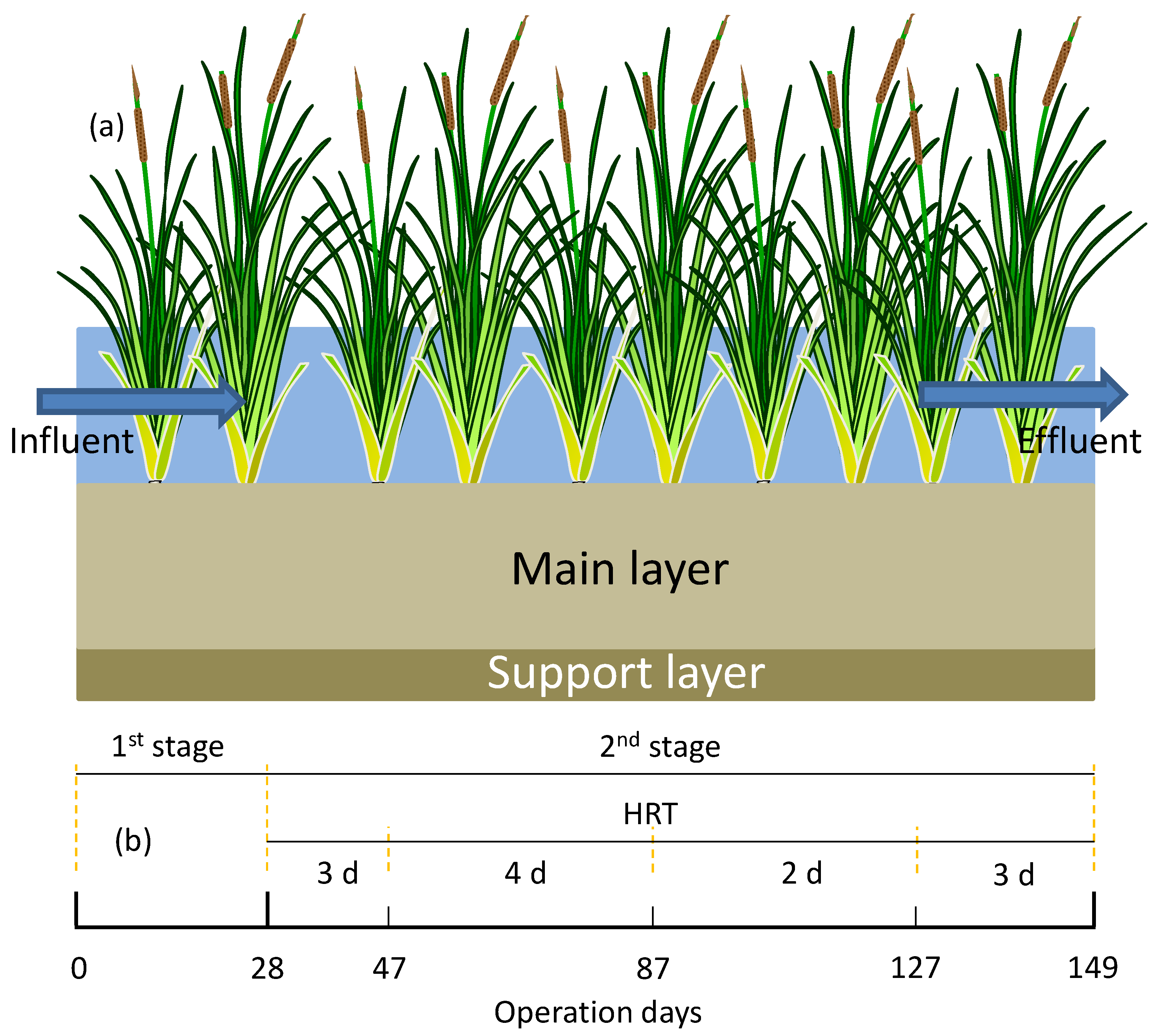
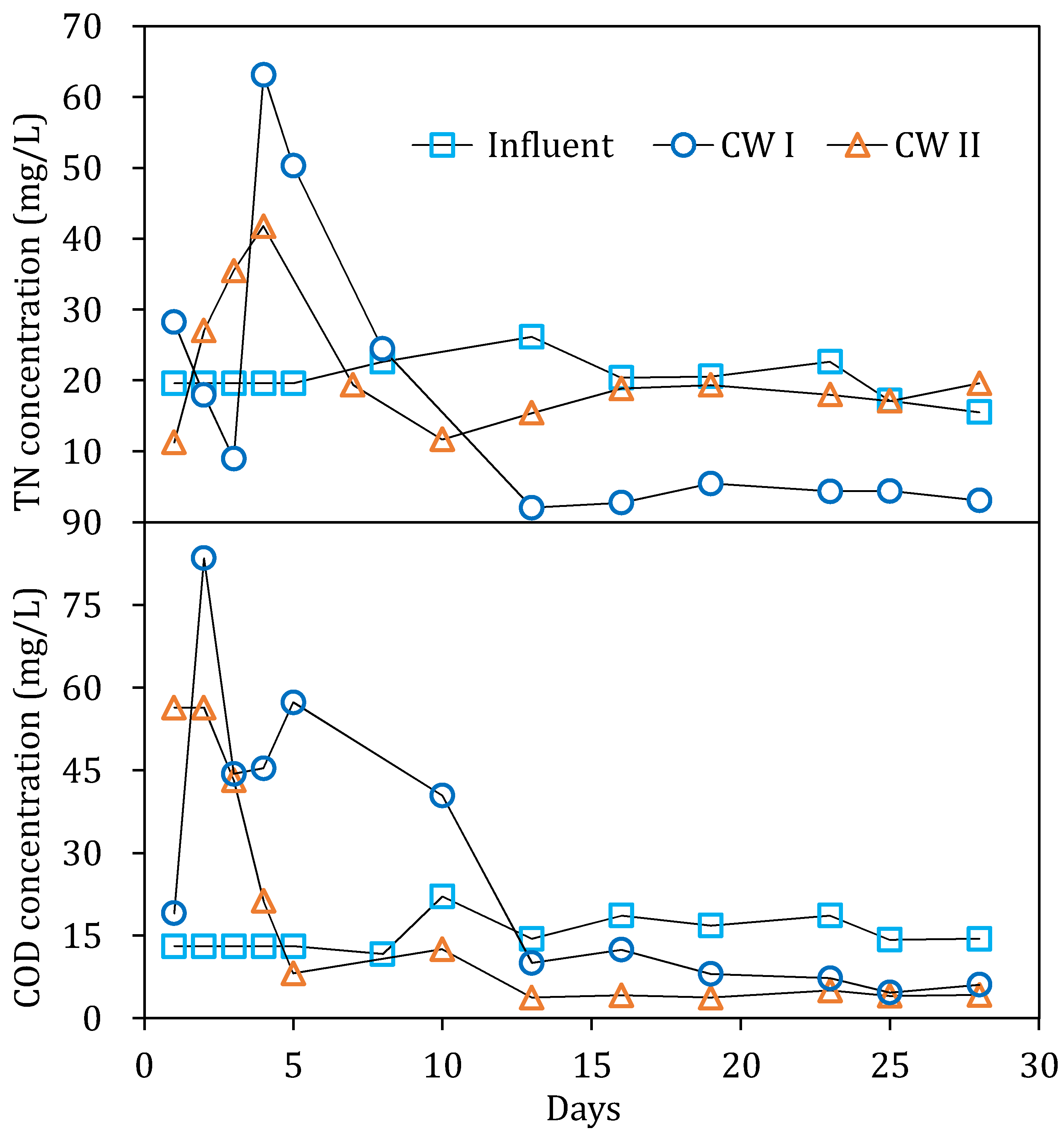
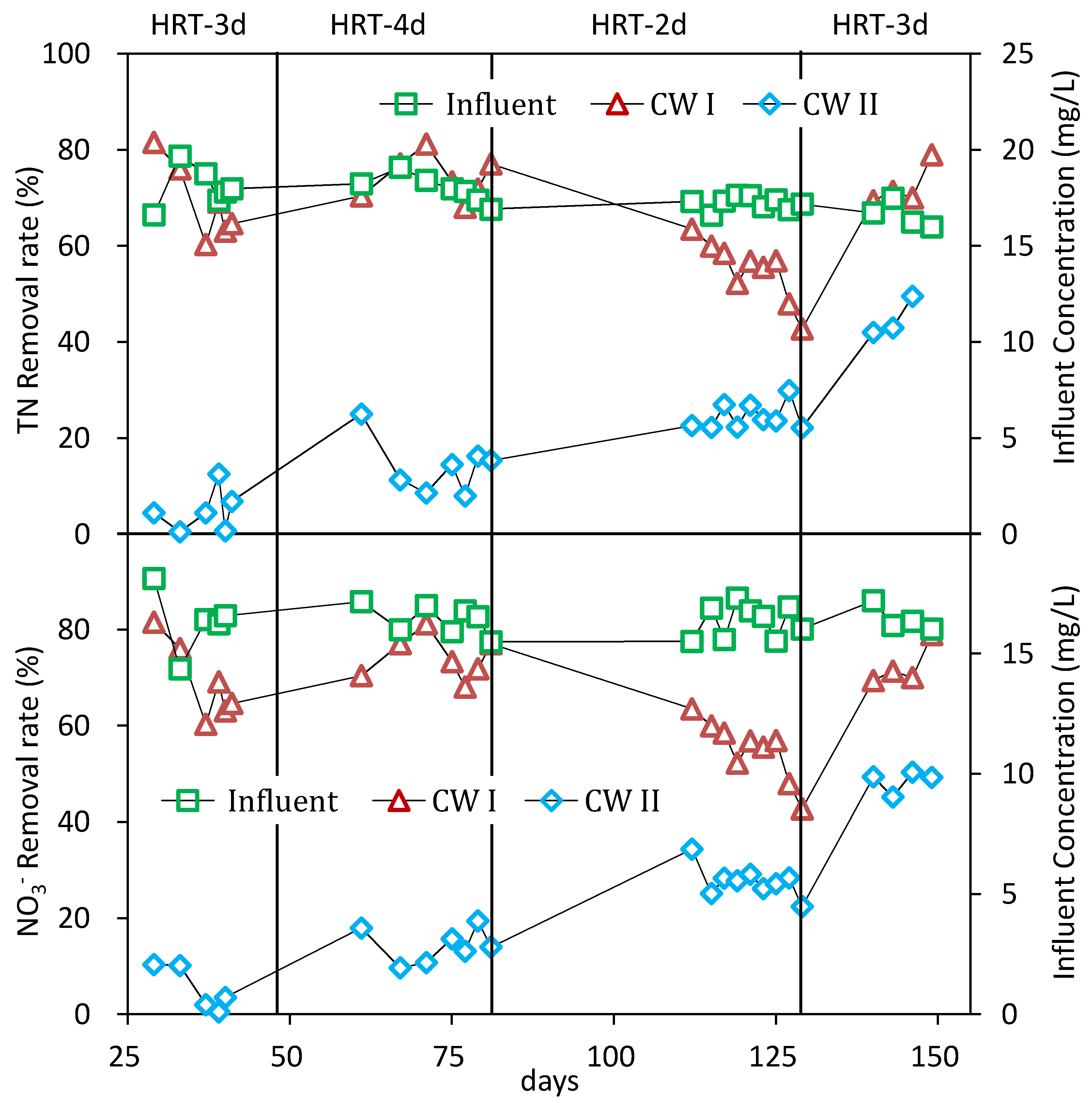
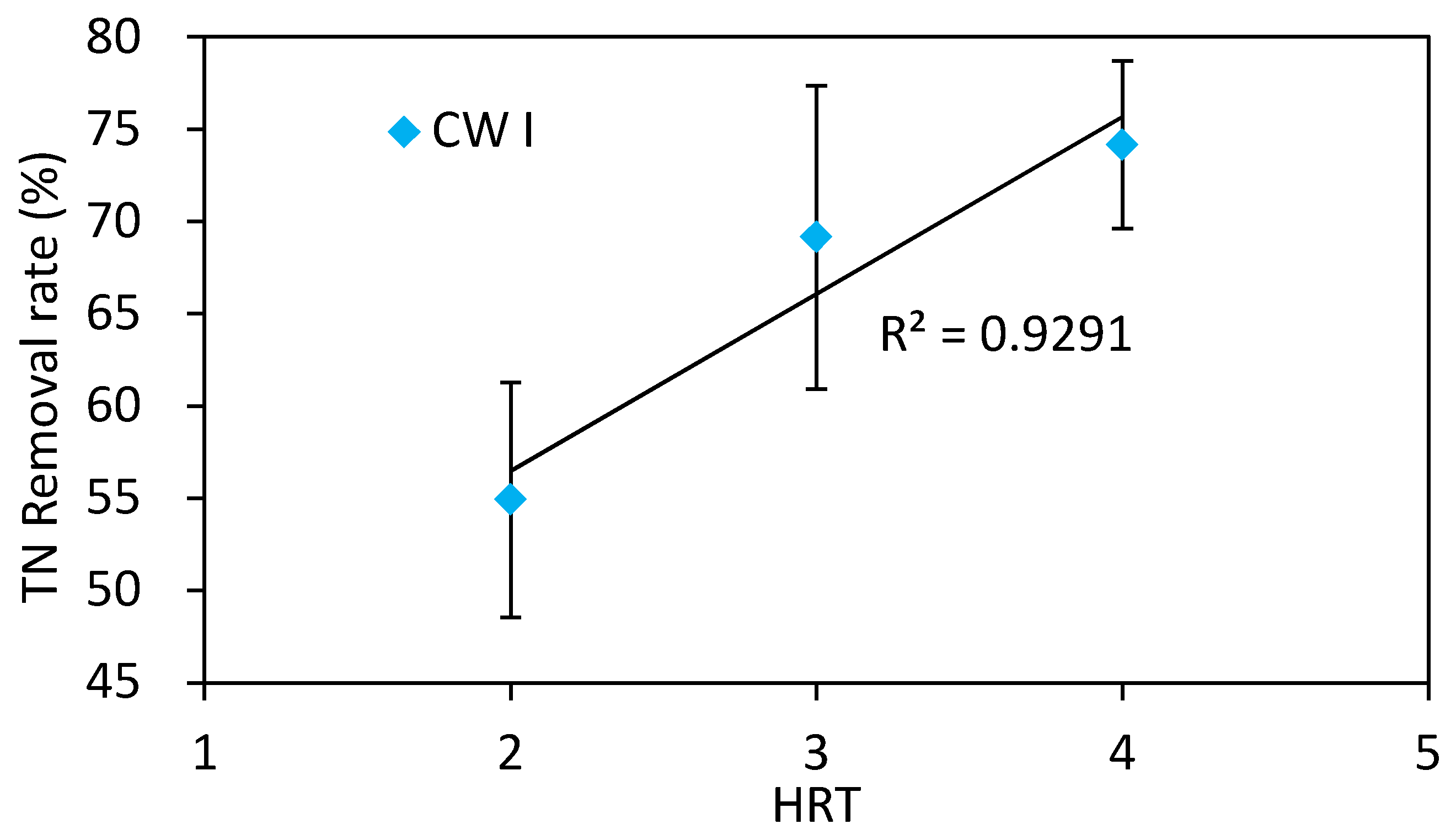
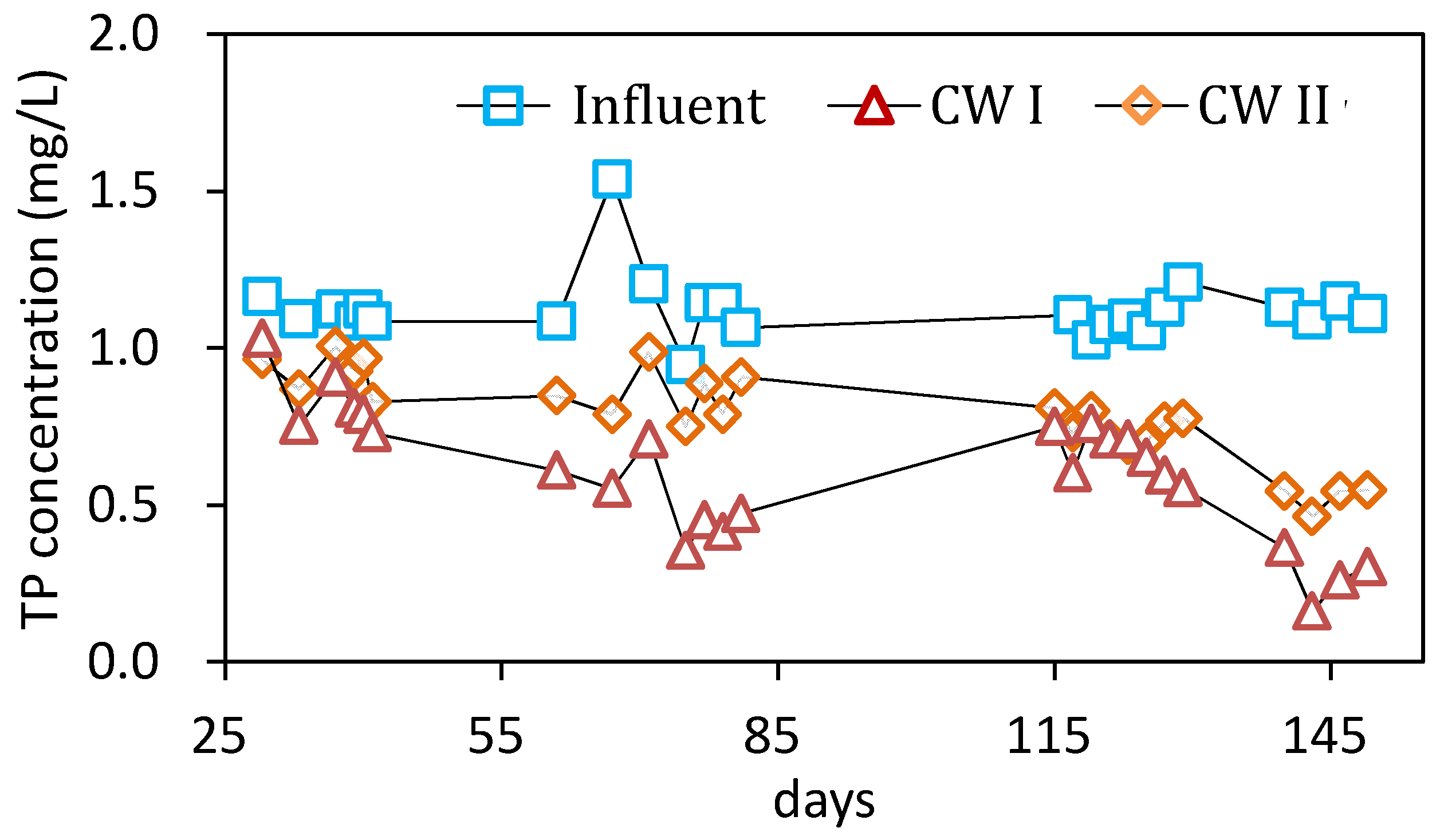
| Reactor | HRT | Influent (mg/L) | Effluent (mg/L) | ||
|---|---|---|---|---|---|
| NH3 | NO2− | NH3 | NO2− | ||
| CW II | 2 | 0.4 ± 0.2 | 0.01 ± 0.01 | 0.1 ± 0.1 | 0.06 ± 0.02 |
| 3 | 0.5 ± 0.2 | 0.01 ± 0.01 | 0.2 ± 0.1 | 0.86 ± 0.4 | |
| 4 | 0.4 ± 0.2 | 0.01 ± 0.01 | 0.1 ± 0.1 | 0.04 ± 0.02 | |
| CW I | 2 | 0.4 ± 0.2 | 0.01 ± 0.01 | 0.3 ± 0.1 | 0.17 ± 0.02 |
| 3 | 0.5 ± 0.2 | 0.01 ± 0.01 | 1.0 ± 0.3 | 1.99 ± 0.5 | |
| 4 | 0.4 ± 0.2 | 0.01 ± 0.01 | 0.8 ± 0.3 | 0.69 ± 0.3 | |
© 2018 by the authors. Licensee MDPI, Basel, Switzerland. This article is an open access article distributed under the terms and conditions of the Creative Commons Attribution (CC BY) license (http://creativecommons.org/licenses/by/4.0/).
Share and Cite
Wang, T.; Wang, H.; Chang, Y.; Chu, Z.; Zhao, Y.; Liu, R. Enhanced Nutrients Removal Using Reeds Straw as Carbon Source in a Laboratory Scale Constructed Wetland. Int. J. Environ. Res. Public Health 2018, 15, 1081. https://doi.org/10.3390/ijerph15061081
Wang T, Wang H, Chang Y, Chu Z, Zhao Y, Liu R. Enhanced Nutrients Removal Using Reeds Straw as Carbon Source in a Laboratory Scale Constructed Wetland. International Journal of Environmental Research and Public Health. 2018; 15(6):1081. https://doi.org/10.3390/ijerph15061081
Chicago/Turabian StyleWang, Tong, Haiyan Wang, Yang Chang, Zhaosheng Chu, Yaqian Zhao, and Ranbin Liu. 2018. "Enhanced Nutrients Removal Using Reeds Straw as Carbon Source in a Laboratory Scale Constructed Wetland" International Journal of Environmental Research and Public Health 15, no. 6: 1081. https://doi.org/10.3390/ijerph15061081
APA StyleWang, T., Wang, H., Chang, Y., Chu, Z., Zhao, Y., & Liu, R. (2018). Enhanced Nutrients Removal Using Reeds Straw as Carbon Source in a Laboratory Scale Constructed Wetland. International Journal of Environmental Research and Public Health, 15(6), 1081. https://doi.org/10.3390/ijerph15061081






